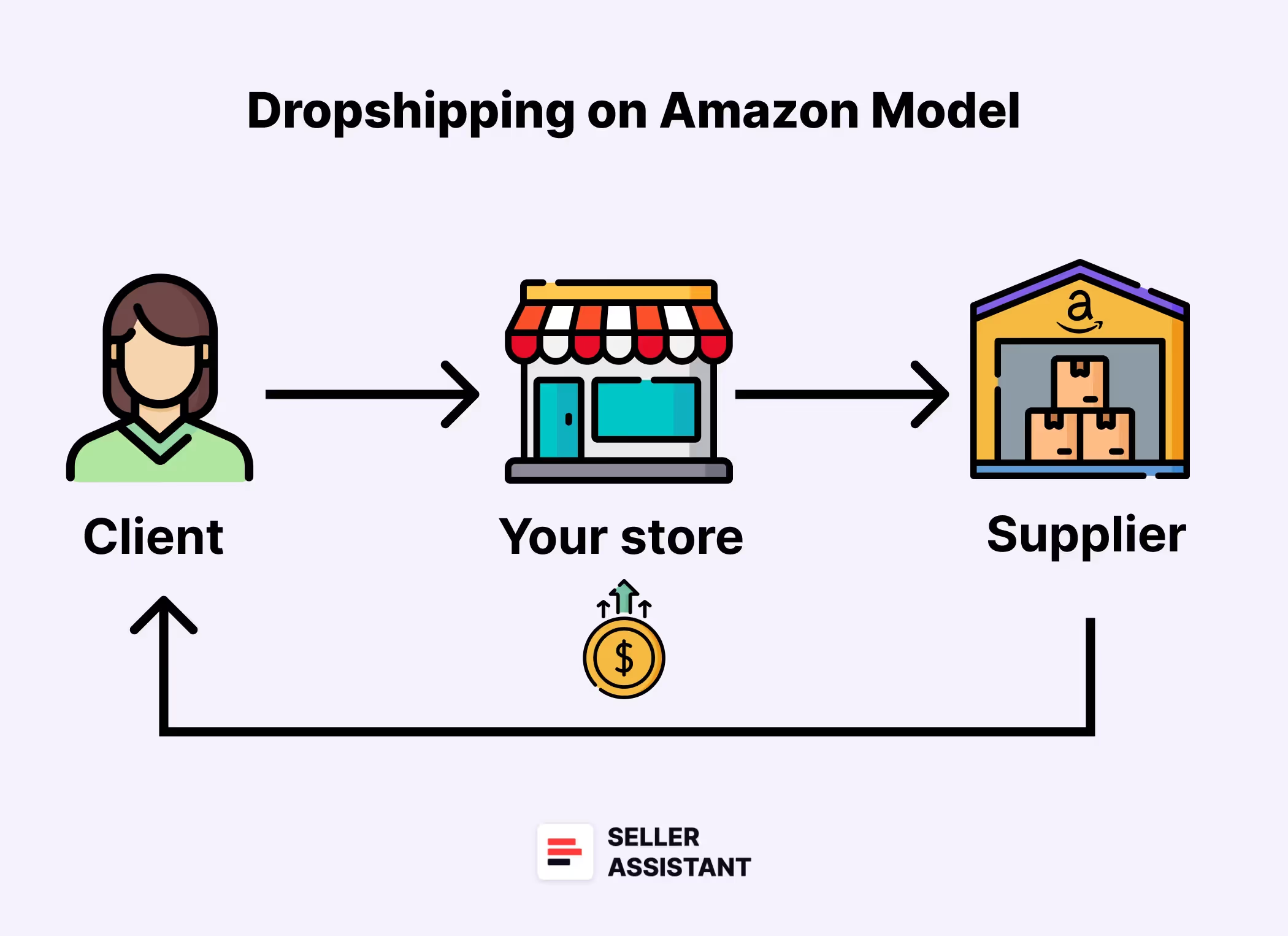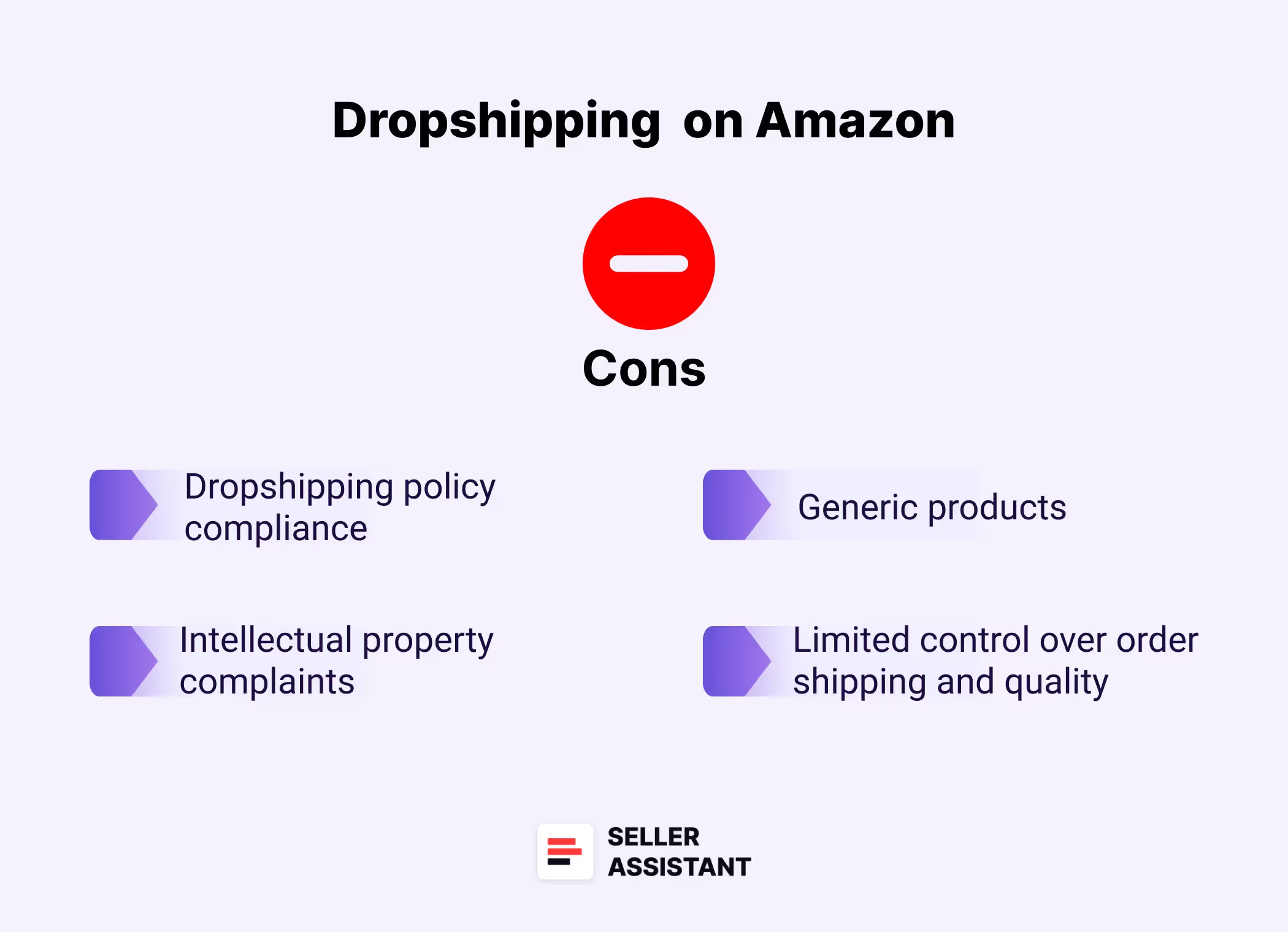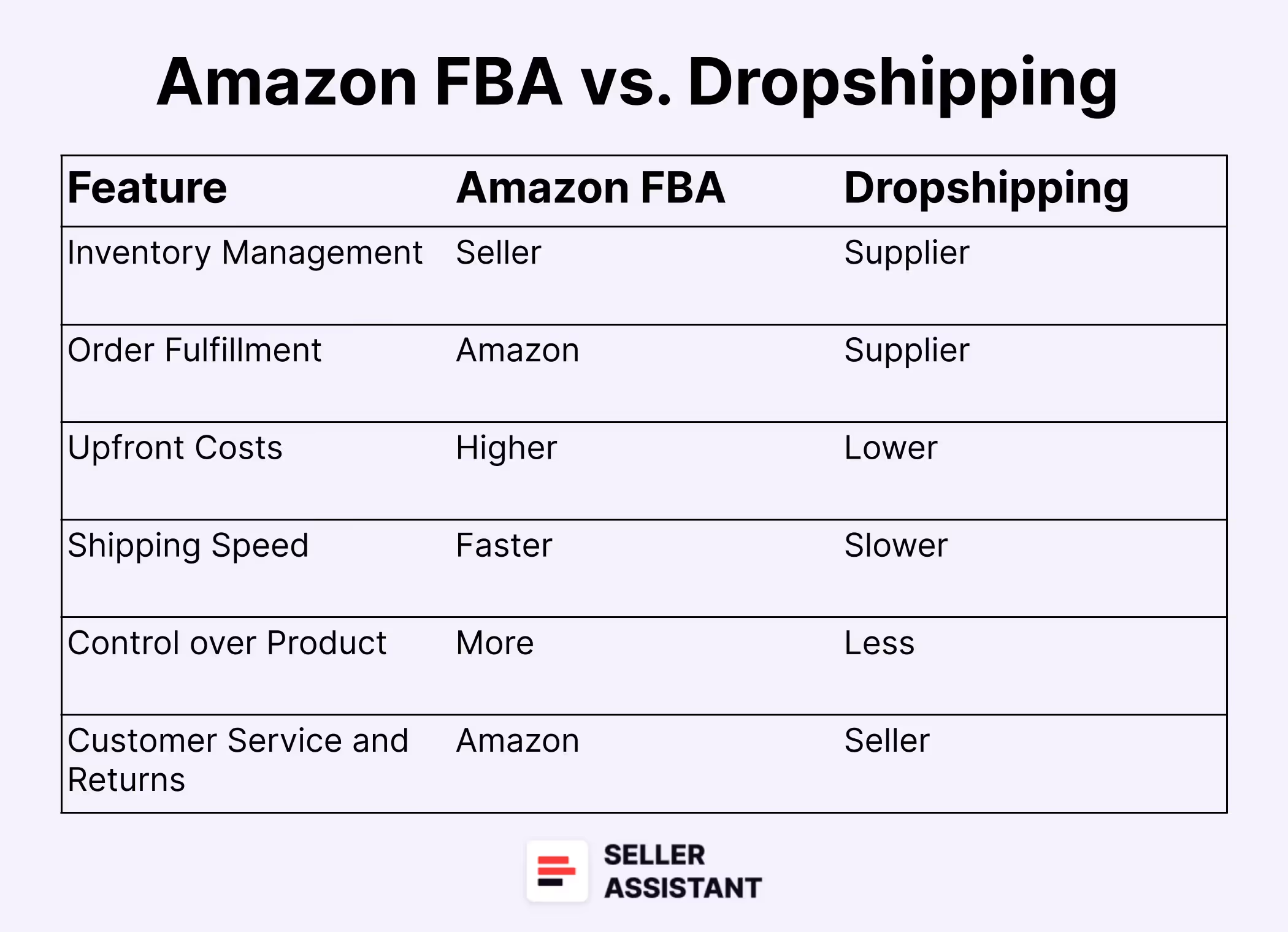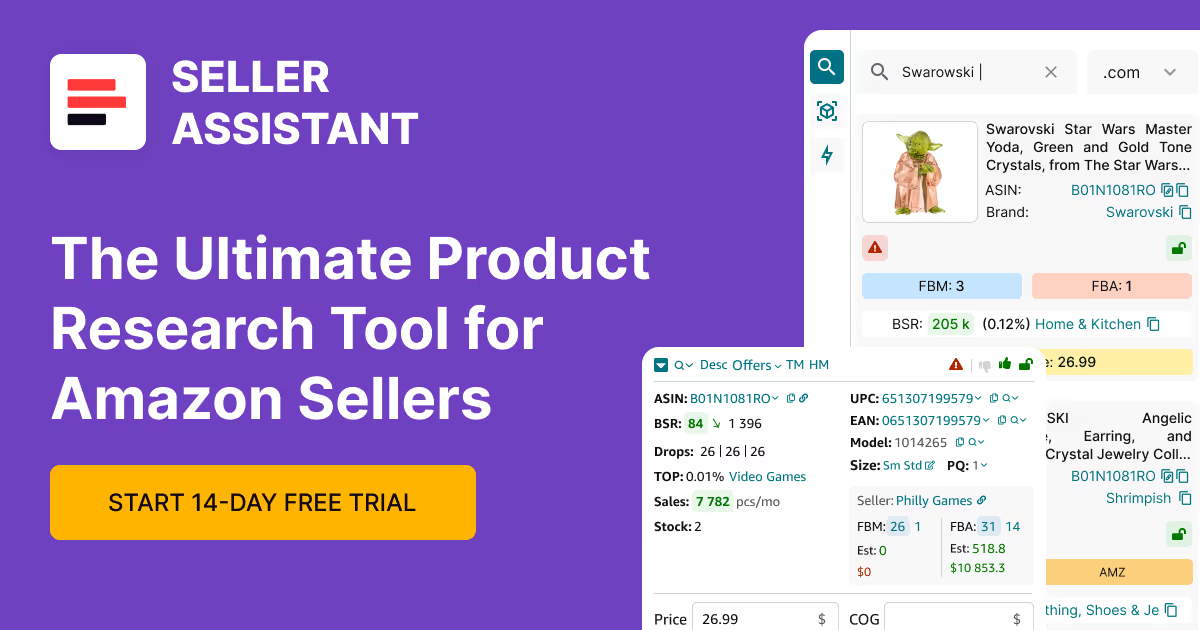Amazon FBA vs Dropshipping
Download Amazon Seller Guide
This guide will help you get started, understand the basics of Amazon selling, and explain in simple words how it all works.

Amazon FBA (Fulfillment by Amazon) is the method of fulfilling your inventory, while dropshipping is one of the ways to sell on Amazon. Amazon FBA simplifies logistics by handling storage, packaging, and shipping, allowing sellers to focus on sales. On the other hand, with dropshipping, you don't need to deal with the inventory at all, as products are shipped directly from the supplier to the customer.
Each model comes with its advantages and challenges, and it's important to understand them before making your choice. This post gives insights into Amazon FBA and dropshipping and explains the difference.
What Is Amazon FBA?
.avif)
Amazon FBA, or Fulfillment by Amazon, is a service provided by Amazon to sellers where Amazon manages the storage, packaging, shipping, and customer support of your products for a fee.
This fulfillment method is popular among Amazon sellers because it helps them easily set up and expand their business.
Related: How Does Amazon FBA Work. Is Amazon FBA Worth it?
Selling on Amazon: How to Make Money?
How to Sell on Amazon for Beginners - Complete Guide
Overview of Amazon FBA services to sellers
- Storage
You ship your items to Amazon’s extensive network of fulfillment centers globally, which helps you save space and enables swift delivery to customers.
- Fulfillment
Amazon handles picking, packing, and shipping of your product once a customer places an order.
- Shipping
Utilizing FBA allows you to offer fast shipping options due to the proximity of fulfillment centers to your customers. Additionally, by opting into Amazon Prime, you can provide Prime members with quick, free shipping, potentially boosting your sales.
- Customer service
Amazon takes charge of customer service, addresses inquiries related to order shipping, and manages refunds and returns for dissatisfied customers.
How does Amazon FBA work?
When you set up a seller account on Amazon and choose a product to sell, you need to decide on the delivery method to the customer. You can either handle fulfillment yourself or opt for FBA.
Choosing FBA means preparing and shipping your inventory to an Amazon fulfillment center, where Amazon stores your products until they are purchased. Upon purchase, Amazon’s staff packages and dispatches the item directly from their fulfillment center to the customer.
Amazon FBA in steps
Step 1. Add your inventory to FBA
You start by adding your inventory to FBA through your Seller Central.
- For new products select FBA under the Offer tab;
- For existing products, go to Inventory > Manage All Inventory, click Edit, and then Change to Fulfilled by Amazon.

Related: Seller Assistant Extension Review
Seller Assistant — the Ultimate Tool for Amazon Online Arbitrage
How to Dropship on Amazon with Seller Assistant
Amazon Wholesale: How to Sell Wholesale on Amazon
Step 2. Prep and send inventory
Prepare, label, and package your products according to Amazon’s specifications to avoid delays and additional costs; then, ship them to an Amazon fulfillment center via the Send to Amazon process in your Seller Central.
Step 3. Amazon stores your products
Once received, Amazon stores your items in their warehouse, with inventory levels trackable via your Seller Central.
Step 4. A customer makes a purchase
When a product is ordered through FBA, Amazon processes the order.
Step 5. FBA fulfillment
Amazon staff picks, packs, and ships your product, handling all customer service issues, including returns, refunds, and inquiries.
Step 6. Payment
Amazon processes the customer’s payment, deducts FBA fees, and deposits the balance into your seller account.
Step 7. Manage inventory
Maintain adequate inventory levels to avoid both stock-outs and excessive storage fees. Monitor, plan, and replenish your stock efficiently.
Related: How to Send Products to Amazon FBA
Pros and Cons of Amazon FBA
Amazon FBA offers both advantages and challenges. On the one hand, it helps you fulfill orders to customers and ensures high-quality customer service, on the other – it incurs fees.
FBA pros
.avif)
Streamlined delivery
FBA delegates logistics to Amazon, freeing up your time and resources to concentrate on product sourcing and sales growth. This is particularly beneficial for new or resource-limited sellers.
Customer service
Amazon handles customer service for FBA sellers, dealing with inquiries related to order shipments, and managing refunds and returns for dissatisfied customers.
Buy Box advantage
FBA sellers automatically qualify for the Buy Box (Featured Offer), enhancing their sales opportunities. Amazon gives priority to FBA listings in the Featured Offer selection, increasing the likelihood that these products appear higher in search results and win the Buy Box, thereby growing sales.
FBA cons
.avif)
FBA fees
The service includes various fees, such as storage fees determined by the size and weight of items, fulfillment fees per item, and additional costs for heavy and bulky or hazardous materials. It's important to carefully evaluate these fees to determine if FBA is financially viable for your products.
Long-term storage fees
Inventory that remains in Amazon warehouses for prolonged periods incurs long-term storage fees, which can be problematic for seasonal items or slow-moving products.
Strict preparation guidelines
FBA sellers must adhere to precise inventory preparation and labeling guidelines. Failure to comply can result in your products being repackaged at your expense, causing delivery delays.
What Is Amazon Dropshipping?
.avif)
Amazon dropshipping is a business model where a seller offers products on Amazon without maintaining a physical inventory. Instead, when a customer places an order, the seller buys the product from a third-party supplier who ships it directly to the customer.
In this model, the seller earns a profit from the difference between the purchase price from the supplier and the selling price on Amazon. The goal is to maximize this price difference.
Dropshipping is attractive because it's easy and inexpensive to start, contributing to its popularity among Amazon sellers. However, it's important to adhere to Amazon’s strict dropshipping policy, which includes identifying yourself as the seller of record on your products. Non-compliance can lead to Amazon deactivating your listings or banning your account, resulting in potential financial losses.
Related: How to Dropship on Amazon in 2024
Amazon dropshipping parties
- Seller
As the business owner, dropshipper lists products on Amazon and handle customer service and returns.
- Supplier
A third-party company responsible for storing, packaging, and delivering the products directly to the customer.
- Customer
The person who buys the product through your Amazon listing.
- Amazon
The online platform where you list your products and where customers make their purchases.
How does Amazon dropshipping work?

In dropshipping, you act as a bridge between customers and suppliers. You find profitable products to sell on Amazon that will be popular with the buyers and don’t have any potential risks or alerts. After that, you identify reliable suppliers to store and ship them.
When a customer buys something from you, you order it from the supplier who then delivers it directly to the customer. This way, you don't need to keep any inventory yourself.
Amazon dropshipping in steps
Step 1. Open an Amazon seller account
Start by setting up your seller profile on Amazon. Choose between an Individual plan for fewer than 40 sales per month or a Professional plan if you expect more than 40 sales per month.
Step 2. Research a product to sell
Identify a product that offers high-profit potential. Evaluate demand, competition, and profit margins. Utilize product sourcing software, Seller Assistant, to choose products that sell well and don’t have issues like IP alerts, restrictions, or other flags.

Step 3. Find a reliable dropshipping supplier
Select a supplier who provides the desired product at a competitive price and is familiar with Amazon's prep and shipping standards. Ensure they have a solid reputation and reliable customer service.
Step 4. List Your Product on Amazon
Add your offer to an existing listing on Amazon that matches your product. Go to Inventory > Add a Product in your Seller Central account. Enter the product's ASIN, choose the condition, and list it for sale.
Step 5. Receive an order
When a customer purchases your product, Amazon will alert you to the sale.
Step 6. Order confirmation to the customer
Amazon automatically confirms the order with the customer, providing details such as the order number and estimated delivery date.
Step 7. Forward the order to your supplier
Pass the order details, including product information and customer address, to your supplier.
Step 8. Supplier ships the order
Your supplier locates the product, packages it following Amazon's standards, and dispatches it directly to the customer.
Step 9. Customer receives their product
The customer receives their order directly from the supplier, completing the transaction without your direct involvement in handling the product.
Pros and Cons of Amazon Dropshipping
With Amazon dropshipping, you can start your business with low investment and risk, but it also has a number of downsides. Therefore, it's important to consider its benefits and challenges before diving in.
Pros of Amazon dropshipping

Low initial costs
Dropshipping on Amazon requires minimal initial investment compared to other business models. There’s no need to purchase inventory upfront or pay for warehouse space and packaging materials. This makes it an attractive option for sellers new to Amazon or those with limited financial resources.
No inventory management
With fulfillment outsourced to suppliers, you don’t need to take care of inventory management. This allows you to concentrate on business tasks like product research and customer service.
Seller tools help find products to sell
Identifying profitable products is a major challenge in dropshipping. Tools like the Seller Assistant can simplify this process, helping you quickly find lucrative opportunities and avoid products with potential issues such as restrictions or intellectual property complaints.
Cons of Amazon dropshipping

Compliance with dropshipping policies
As a dropshipper on Amazon, you must operate as the seller of record, which means that all product-related documents like invoices and packing slips are in your name. No supplier branding on the products or packaging is allowed. It can be a problem for sellers to find suppliers who agree to take care of this.
Risk of intellectual property complaints
Dropshipping often involves selling products from other brands, which may be protected by intellectual property rights and not authorized for third-party sales. Violations can lead to IP complaints and may result in deactivated listings and significant financial losses if you cannot provide proper documentation.
Limited control over fulfillment and quality
Since inventory is not under your direct control and fulfillment is handled externally, there is limited oversight over shipping times and product quality. In case of shipping delays, there’s not much you can do. This can create negative customer experience and feedback, or product returns in case of poor product quality.
What Is the Difference between Amazon FBA and Dropshipping?
Both with Amazon FBA and dropshipping, you don’t deal with the inventory.
The key difference is that with Amazon FBA you prepay the products you sell, and Amazon fulfills them for you. That means you take a risk if a product doesn’t sell or gives you less profit than you expected.
With dropshipping, you don’t have to invest in a product until the buyer pays for it. That essentially reduces your risks of failure with a product. However, there are other risks involved, like little control over fulfillment and quality.

Amazon FBA
- You purchase inventory in advance and send it to Amazon warehouses;
- Amazon stores, picks, packs, and ships your orders to customers;
- You pay Amazon fees for storage and fulfillment;
- Amazon handles customer service and returns on your behalf.
Amazon dropshipping
- You don't hold any inventory yourself;
- When a customer orders something, you forward the order to your supplier;
- The supplier stores, packs, and ships the order directly to the customer;
- You pay the supplier for the product and a markup for your profit;
- You handle customer service and returns.
When Should You Go for FBA?

FBA can be a helpful tool for some sellers on Amazon. It can make things much easier and allow you to focus on growing your business. If these situations apply to you, then FBA might be a good choice for your business on Amazon.
- Lots of sales
If you sell a lot of items, FBA can save you time and effort. Amazon has big warehouses and can handle packaging and shipping for you, freeing you up to find new products and sell more.
- Less hands-on work
FBA can be a good option if you don't want to deal with storing your products or shipping them yourself. Amazon takes care of everything, including customer service for FBA orders.
- No shipping partner
If you don't already have an existing shipping partner, FBA can be a good solution. Amazon uses its own network to get your products to customers quickly.
- Limited storage space
If you don't have a lot of space to store your products, FBA can help. Amazon has many warehouses where they can keep your items safe.
- Standard products
FBA works best for products that are standardized in size and weight. This makes it easier for Amazon to store and ship them. If you sell heavy and bulky, meltable, or other non-standard products, a third-party fulfillment partner may be a better choice.
When Should You Go for Dropshipping?

Amazon dropshipping can be a good option if you're looking for a low-cost way to get started with e-commerce or want to test different products. Here's a breakdown of when dropshipping might be a good fit for you.
- Starting out
Dropshipping requires minimal upfront investment compared to buying inventory. This makes it a good option for new sellers to start on Amazon.
- Limited funds
Compared to buying inventory in advance, dropshipping requires minimal upfront investment. This makes it a perfect way to start selling for those having limited financials without a big risk. It's ideal for new sellers or those with limited money.
- Focus on product research
With dropshipping, you don't need to worry about storing or managing inventory. This frees up your time to research and find profitable products to sell online.
- You test what to sell
Dropshipping allows you to offer a wider variety of products without the risk of getting stuck with unsold inventory. This can be helpful when you're still figuring out what sells best to your target audience.
- Limited space
If you don't have the space to store inventory yourself, dropshipping entirely eliminates that need.
Can You Use Dropshipping and Fulfillment by Amazon Together?
Yes, you can sometimes use dropshipping and FBA together in your sales. It can be a creative way to maximize your offerings. Here's how.
Hybrid approach
- Faster-selling products with FBA
For popular items that sell quickly, consider using FBA. This allows you to benefit from Amazon's fast fulfillment times and use Amazon Prime benefits.
- Slower-moving products with dropshipping
For less popular products or those that sell slower, dropshipping can be a good option. You avoid the upfront cost and storage burden of slow-moving inventory, while still offering them to your customers.
FAQ
Is Amazon FBA or dropshipping better?
There's no single "better" option. FBA offers faster fulfillment and control but has upfront costs. Dropshipping is cheaper to start but means less control and potentially slower shipping. Choose based on your budget and priorities.
Is Amazon FBA always profitable?
No, FBA isn't guaranteed profit. Factor in storage fees, fulfillment costs, and product margins to see if it makes financial sense for your specific products and sales volume. Use Seller Assistant’s FBM&FBA Profit Calculator to ensure the product is profitable.
Is it worth it to dropship on Amazon?
Dropshipping on Amazon can be a low-cost entry point, but expect lower profits and less control. It might be worth it if you research and list many products and wait until they sell.
Is Amazon FBA still worth it?
FBA can still be worth it for taking care of fulfillment and customer service, faster shipping, and control over inventory. However, it requires a higher upfront cost and works best for sellers with consistent sales.
Final Thoughts
In conclusion, both Amazon FBA and dropshipping have their own advantages and disadvantages. The best choice for you will depend on your specific business needs and resources.
Whichever method you choose, be sure to carefully select the products you sell. Make sure they will sell, bring you profit, and don’t create problems like IP complaints. Use product sourcing tools to make a wise choice.
The best product sourcing software that helps choose such products is Seller Assistant. It combines three extensions: Seller Assistant Extension, IP Alert, and VPN by Seller Assistant, tools: Price List Analyzer,Brand Analyzer, Seller Spy, Bulk Restrictions Checker, and API integrations, and features: Storefront Widget,Side Panel View,FBM&FBA Profit Calculator, Quick View, ASIN Grabber,UPC/EAN to ASIN converter, Stock Checker, and other features that help quickly find high-profit deals. Seller Assistant also offers integration with Zapier allowing to create custom product sourcing workflows.

.svg)













